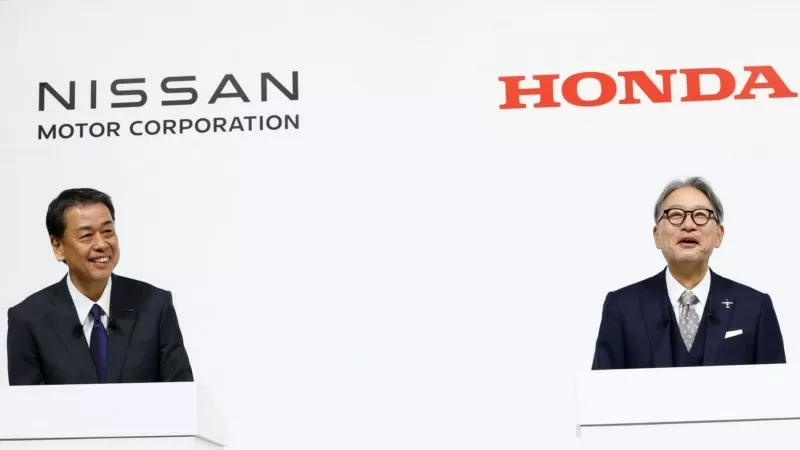TOKYO – In a major move towards consolidation, Japanese automakers Honda and Nissan have announced plans to merge and form the world’s third-largest automaker by sales. This decision comes at a time when the industry is undergoing a significant transformation, shifting away from fossil fuels and towards electric vehicles.
The two companies have signed a memorandum of understanding and have also included smaller Nissan alliance member, Mitsubishi Motors, in their discussions about integrating their businesses. Honda’s President, Toshihiro Mibe, stated that the companies will unify their operations under a joint holding company, with Honda initially leading the new management. The aim is to have a formal merger agreement by June and complete the deal by August 2026.
While no dollar value has been given, the talks are just beginning and there are many aspects that need to be studied and discussed. However, Mibe stated that the possibility of the merger not being implemented is slim.
Both Honda and Nissan have been lagging behind their competitors in the electric vehicle market and are now looking to make up for lost time and cut costs. The news of a possible merger surfaced earlier this month, with reports suggesting that the talks were partly driven by Foxconn, a Taiwanese iPhone maker, wanting to collaborate with Nissan. Nissan currently has an alliance with Renault SA of France and Mitsubishi.
If the merger goes through, the resulting company would be worth over $50 billion, based on the market capitalization of all three automakers. This would give them the scale to compete with industry giants like Toyota Motor Corp. and Volkswagen AG. However, even after the merger, Toyota would remain the leading Japanese automaker, having produced 11.5 million vehicles in 2023. Together, Honda and the Nissan alliance, along with Mitsubishi, would produce approximately 8 million vehicles. In comparison, Honda produced 4 million vehicles and Nissan produced 3.4 million in 2023, while Mitsubishi produced just over 1 million.
The three companies have already announced plans to share components for electric vehicles, such as batteries, and to jointly research software for autonomous driving. This collaboration was initiated in March and further solidified in August, highlighting the shared focus on adapting to the industry’s move towards electrification.
Honda, Japan’s second-largest automaker, is seen as the only potential partner that could rescue Nissan, which has been struggling since the scandal involving its former chairman, Carlos Ghosn, in late 2018. Ghosn was arrested on charges of fraud and misuse of company assets, which he denies, and eventually fled to Lebanon after being released on bail. In a video conference with reporters in Tokyo, Ghosn called the planned merger a “desperate move”.
Honda stands to benefit from the merger by gaining access to Nissan’s truck-based body-on-frame large SUVs, such as the Armada and Infiniti QX80, which they currently do not have. These vehicles have large towing capacities and impressive off-road performance, according to Sam Fiorani, vice president of AutoForecast Solutions. Additionally, Nissan has years of experience in building batteries, electric vehicles, and hybrid powertrains, which could greatly assist Honda in developing their own EVs and next-generation hybrids.
However, Nissan has been facing financial troubles and reported a quarterly loss of $61 million in November. As a result, the company announced plans to slash 9,000 jobs, or 6% of its global workforce, and reduce global production capacity by 20%. The recent management reshuffle saw CEO Makoto Uchida take a 50% pay cut, taking responsibility for the company’s financial woes. Uchida emphasized the need for Nissan to become more efficient and responsive to market trends, rising costs, and global changes.
“We anticipate that if this integration comes to fruition, we will be able to deliver even greater value to a wider customer base,” said Uchida.
Fitch Ratings recently downgraded Nissan’s credit outlook to “negative”, citing worsening profitability, partially due to price cuts in the North American market. However, they also noted that the company has a strong financial structure and solid cash reserves of $9.4 billion. This, combined with the lowered share price, makes Nissan an attractive prospect for the merger.
The decision to merge reflects a wider trend towards consolidation in the industry. In a routine briefing, Cabinet Secretary Yoshimasa Hayashi stated that he could not comment on the details of the automakers’ plans, but emphasized the


